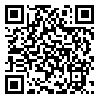Volume 1, Issue 4 (December 2014)
J. Food Qual. Hazards Control 2014, 1(4): 108-112 |
Back to browse issues page
H. Tajik 
 , M. Raeisi *
, M. Raeisi * 
 , S.M. Razavi Rohani
, S.M. Razavi Rohani 
 , M. Hashemi
, M. Hashemi 
 , M. Amin Zare
, M. Amin Zare 
 , H. Naghili
, H. Naghili 
 , D. Rozbani
, D. Rozbani 
 , D. Ben Ammar
, D. Ben Ammar 


 , M. Raeisi *
, M. Raeisi * 
 , S.M. Razavi Rohani
, S.M. Razavi Rohani 
 , M. Hashemi
, M. Hashemi 
 , M. Amin Zare
, M. Amin Zare 
 , H. Naghili
, H. Naghili 
 , D. Rozbani
, D. Rozbani 
 , D. Ben Ammar
, D. Ben Ammar 

Department of Public Health, Faculty of Health, Golestan University of Medical Sciences, Gorgan, Iran , raeisi.mojtaba@yahoo.com
Abstract: (4673 Views)
Background: Escherichia coli and Staphylococcus aureus as important food-borne pathogens are the main concerns of food producers and consumers which create a lot of problems worldwide. The objective of this study was to investigate the inhibitory effect of monolaurin alone and in combination with EDTA on viability of E. coli and S. aureus in culture media and Iranian white cheese.
Methods: The minimum inhibitory concentration of monolaurin and EDTA was determined by broth microdilution susceptibility test. In the next stage, 108 CFU/g of E. coli and S. aureus and different concentrations of monolaurin and EDTA were added. Samples were maintained at 4 °C for 9 days. Antibacterial effect of monolaurin and EDTA was evaluated on days 0, 1, 3, 5, 7 and 9 by the specific media. Statistical analysis was made using analysis of variance (ANOVA) by SPSS program (16.0) to compare means with a significant difference when p<0.05.
Results: Monolaurin alone in both in vitro and in vivo condition had limited effect on E. coli growth but this effect was increased when it was used in combination with EDTA (p<0.05). Monolaurin showed strong antibacterial effect on S. aureus which was increased significantly when used in combination with EDTA (p<0.05). Preservation time had significant effect on antibacterial effect of monolaurin on both pathogenic bacteria (p<0.05).
Conclusion: Monolaurin can be used in combination with EDTA to decrease contamination risks and growth of pathogenic bacteria in Iranian white cheese.
Methods: The minimum inhibitory concentration of monolaurin and EDTA was determined by broth microdilution susceptibility test. In the next stage, 108 CFU/g of E. coli and S. aureus and different concentrations of monolaurin and EDTA were added. Samples were maintained at 4 °C for 9 days. Antibacterial effect of monolaurin and EDTA was evaluated on days 0, 1, 3, 5, 7 and 9 by the specific media. Statistical analysis was made using analysis of variance (ANOVA) by SPSS program (16.0) to compare means with a significant difference when p<0.05.
Results: Monolaurin alone in both in vitro and in vivo condition had limited effect on E. coli growth but this effect was increased when it was used in combination with EDTA (p<0.05). Monolaurin showed strong antibacterial effect on S. aureus which was increased significantly when used in combination with EDTA (p<0.05). Preservation time had significant effect on antibacterial effect of monolaurin on both pathogenic bacteria (p<0.05).
Conclusion: Monolaurin can be used in combination with EDTA to decrease contamination risks and growth of pathogenic bacteria in Iranian white cheese.
Type of Study: Original article |
Subject:
Special
Received: 14/06/30 | Accepted: 14/09/23 | Published: 14/12/08
Received: 14/06/30 | Accepted: 14/09/23 | Published: 14/12/08
| Rights and permissions | |
 |
This work is licensed under a Creative Commons Attribution-NonCommercial 4.0 International License. |
